Feature: How to Grow Tomatoes
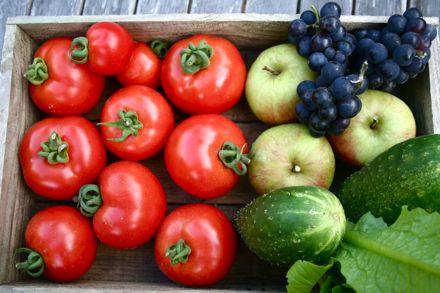
Tomatoes are a pure delight to grow. Watching your own plants swell to produce sweet, aromatic fruits is one of the true pleasures in life and one that many people repeat year after year. The Tomato is one of the only vegetables that you can grow in a diverse range of shapes, colours and sizes. With around 7500 varieties to choose from you can grow virtually any kind from bulging Beefsteak Tomatoes, to a cascade of sweet cherry Tomatoes or pear-shaped yellow ones to, this year’s fashion, teeny-tiny, pea-sized ones.
Choosing the colour and shape of your home-grown Tomatoes is all well and good but what’s really important is the taste. Nothing beats the intense flavour of a Tomato that tastes like a Tomato. And nothing can really match that Tomatoey aroma that you only get from a vine. Twist a fully-ripe, sun-warmed fruit off the vine and bite into it. You’ll be overcome by the rich and sweet, juiciness of it. It tastes amazing.
Now is the perfect time to fill your garden with row upon row of Tomatoes to toss into salads, couple with Basil and mozzarella to make the perfect Tricoloure, or whizz into a hot aromatic sauce with some Oregano.
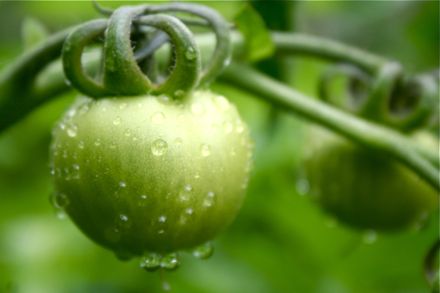
How to Grow
June is a great time to plant Tomatoes out in the garden. It’s warm, there’s no risk of frost and you’ll be giving the plant the perfect environment to flower and set fruit. By the end of Summer you’ll be padding through the garden with a smug look on your face and a trugful of perfectly ripe Tomatoes.
Tomato seed is usually sown back in early Spring, indoors in a heated propagator and the seedlings grown on under cover until planting out time. If you haven’t sown your own then don’t worry, your local garden centre will be full of Tomato seedlings right now. All you need to do is browse the shelves and find the right Tomato for you.
There are essentially two types of Tomato: cordon and bush.
Cordon (or indeterminate) are usually grown as a cordon or singular stem. This is achieved by pinching out the side-shoots that appear between the stem and leaf. It’s best to remove the tip of the stem two leaves above the fourth truss of fruits (for outdoor plants) and above the sixth truss for greenhouse-grown plants. And remember to stake the plants as they can get very top heavy once the Tomatoes begin to swell.
Bush (or determinate) should be left to grow into a small bush and their side-shoots left intact. This will increase the crop and again the plants should be secured to some kind of support to stop them toppling over.
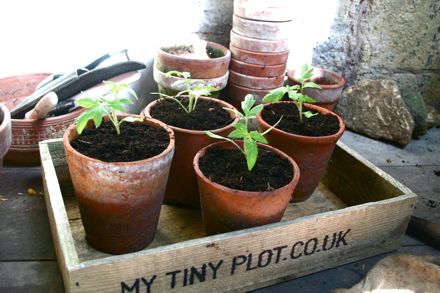
Where to Plant
Surprise, surprise, Tomatoes grow best in full sun so choose the sunniest part of your garden to plant them in. June is a good time to plant them out but ideally you’re looking for a consistent temperature of not lower than 55F (12C) at night. If the temperature is lower than this the plants may not set fruit.
If you have recently purchased your seedlings from a garden centre or you’ve grown them from seed indoors then you’ll need to introduce them to the big outdoors gradually. This process is called ‘hardening off’.
Without hardening your plants off you run the risk of losing your precious seedlings to wilting due to the shock of sudden temperature changes. Your seedlings have been used to being tucked up in the warm temperatures indoors, they don’t take kindly to being thrust outdoors without warning.
Start by putting your plants outside for a few hours a day. Choose an overcast but warmish day and put your seedlings outside, ideally in a bit of shade. Then bring them in once evening starts to set in. Repeat this every day for at least a week (preferably two). Eventually the plants will be able to spend the whole day outside and pretty soon after that the whole evening. If you have a greenhouse or coldframe then you can use this as another step in the hardening process.
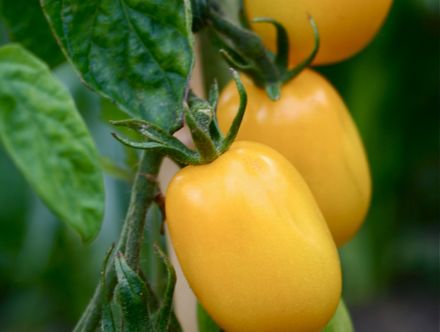
Watering & Feeding
Assuming you have good, rich soil there is no need to feed your Tomatoes until the first button-sized fruits appear. Once the fruitlets appear use a specialist Tomato feed like Tomorite or a Comfrey-based liquid feed. Tomatoes are greedy so feed them weekly.
That said, it’s easy to overfeed a Tomato, especially if the plants are young. A young plant’s delicate roots can’t cope with a solution designed for adult plants. Always follow the instructions on the pack and don’t feed very small plants.
When it comes to watering your Tomato plants the secret is slowly and deeply. Go easy, never rush watering them. Drip irrigation is best. Failing that cut the bottom off a large plastic lemonade bottle and sink it into the ground neck first just next to the plant. Every time you water your plants using the bottle the water will be getting directly to the roots, quickly.
Water your Tomatoes regularly, every two to three days is ideal. But once the weather is cooler and your plants have small fruits on them cut back watering to once a week.
Blight
Every plant has its nemesis and Tomato’s sworn enemy is blight.

Tomato blight is a nasty disease that starts with small brown patches on the stalks and leaves but soon progresses to the fruits. Once infected the Tomatoes quickly turn brown and become inedible. Eventually, they will drop off the plant in a soggy, rotting mess. Eww!
In a wet Summer growing outdoor Tomatoes in the UK is more of a battle with wind and rain than an idyllic growing experience. So pray for sun! Greenhouse-grown Tomatoes will usually escape blight since the spores are airborne and find their way onto the plant via rain drops, but they are not totally immune.
You can’t protect your Tomatoes from blight completely but there are a few things that you can do to give them a fighting chance of survival.
- Grow your own plants from seed or buy vigorous, healthy plants from a trusted source.
- Don’t plant Tomatoes in the same spot as last year.
- Choose disease-resistant varieties (Ferline, for example).
- Remove the bottom leaves up to the first truss of fruits to avoid rain splashing onto the leaves.
- Remove and destroy all plant waste after the growing season.
- Avoid watering on to the leaves. Water directly to the roots and don’t handle plants when the vines are wet.
- Control weeds in and around the plants. Weeds serve as hosts for insects and disease.
- Control pests (particularly aphids) which may transmit disease from plant to plant.
- Remove plants as soon as the tell-tale brown patches are seen. Wash hands and tools with a detergent after handling affected plants.
- Choose a sunny location and provide a removable rain cover if possible.
If you only grow one vegetable this year make it the Tomato. Even if it’s only one plant in a window box on your balcony. That first Tomato will be the best one you have ever tasted. Guaranteed!
A Short History of the Tomato
The origin of the Tomato probably lies in the fifteenth century. Wild plants were first found in Central America and the seed collected by Spanish explorers who traded them with Italian merchants. The seed then found its way to England and eventually they were taken back to America with colonists to the New World.
The Tomato’s path was not an easy one though. Many people mistrusted this new red fruit because of its close relationship to the poisonous Deadly Nightshade plant. As American legend goes, the myth was finally shattered when a young man volunteered to eat a bushel of Tomatoes on the steps of Boston courthouse. The crowd that turned out to watch him die in agony were disappointed.
After that the flood gates were opened and the Tomato grew in popularity until in 1897 Joseph Campbell introduced his Condensed Tomato Soup, a move that made his company rich as well as further cementing the Tomato as a firm favourite.
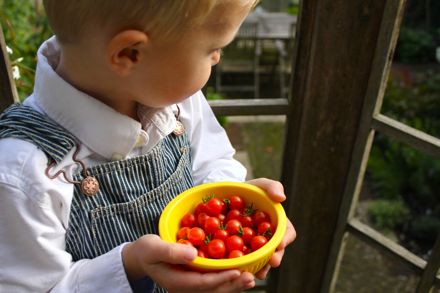
Top Tomato Varieties for Small Gardens
Garden centres and nurseries will stock the tried and tested varieties that tend to do well in our UK weather. Although if you want to grow more unusual varieties then you may need to grow them from seed as there is more choice from seed merchants. Heirloom Tomatoes (open-pollinated varieties that are generally more than 50 year’s old) have become very popular over the past few years but are mostly only available as seed.
Most varieties are suitable for both outdoor and greenhouse growing unless they specify ‘indoor only’.
Moneymaker (cordon) – Well-loved variety, ubiquitous in garden centres at this time of year.
Sungold (cordon) –
Gardeners Delight (cordon) – Reliable variety that produces small, cherry sized Tomatoes. A firm favourite for flavour.
Ferline (cordon) – Great-looking Tomato that produces large beefsteak Tomatoes. Has some resistance to blight.
Tumbler (bush) – Great for hanging baskets
Sweet Pea Currant (cordon but grown as bush) – sweet and abundant, pea-sized Tomatoes
Links
Huge selection of Tomato seeds
http://www.plantsofdistinction.co.uk/
Pea-sized Tomatoes
http://www.victoriananursery.co.uk/
General Tomato Seeds
http://www.dobies.co.uk/
Heirloom Tomatoes
http://www.heirloomtoms.org/
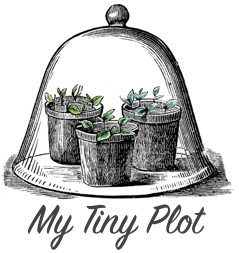 My Tiny Plot
My Tiny Plot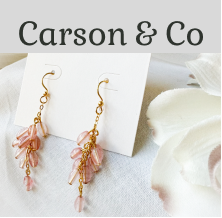



Loved this. I have such a hard time growing tomatoes. Although as I’m in Australia I can’t find the varieties that you grow. But I’m taking your info and will use it this coming summer.
Great information on tomato growing!
The one thing I have failed to do is trim off the bottom leaves. Must do that today!!!
Happy gardening!
Lea
Lea’s Menagerie
Mississippi, USA
Great tips on the tomatoes im trying sungold this year as I had them at a friends house last year and was blown away by the sweetness of them.
It’s fun to see how the love for tomatoes is pretty much universal. I am harvesting a few now and next week should provide an explosion of red, ripe and juicy tomatoes. I will actually put a second round of plants out in late July for a fall harvest. By the end of July the Houston Texas heat has burned everything up and it is too hot for the fruit to set….except for the variety Juliet! It does well throughout the Houston heat. Love your posts…Thanks
I love your website and have been a reader for years even though I am only getting round to starting my garden now, the thing is I was all excited the other day after I carefully planted out some chilli peppers, thyme, tomatoes and tarragon. I came inside feeling chuffed with my efforts only to discover when I went back out later in the day some pesky animal had gobbled them all up, every last leaf and most of the stalk! Do you know what it is? They were quite large plants But were gone in a few hours. We have a feisty jack Russell that I thought would scare most things off but obviously not! Any suggestions or advice? Most of them were in pots on a plastic garden table. Are my hopes of growing veggies to be scuppered?
Growing tomatoes is so popular but I’ve seen so many failures, including my own!
I’ve just invested in a grow house to get things started as the seasons seem to get longer and longer these days!
Pinching out is really starting to work to thicken the foliage out and concentrate the energy on growing fruits.
Really useful article on a much needed subject!
Lisa – probably slugs. They can eat a lot in one sitting. They had my beans that were almost 3 inches high!